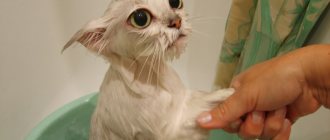White Cat Deafness Study
The fact of deafness of white cats interested scientists several decades ago. In 1997, a large-scale study of the problem was carried out, as a result of which several interesting facts emerged:
- Deafness resulting from the mutation process can be either complete or partial.
- Hearing loss affects about 20% of cats with white fur and non-blue eyes.
White cat of the Kao-mani breed with yellow eyes
- 40% of all cats with heterochromia (different eye colors) have hearing loss, which manifests itself in the ear next to the eye with a blue iris.
White Scottish Fold with different eyes
- 80% of blue-eyed white cats are deaf.
White British cat with blue eyes
Read the article: 20 breeds of white cats.
Natural selection
Animals with pure white fur are extremely rare in nature. This coloring makes them vulnerable and reduces their chances of survival due to the lack of necessary camouflage. Therefore, the opportunity to purchase white cats today has been preserved only thanks to breeders and interest in such pets on the part of buyers. In the world, these animals make up no more than 5% of the entire population.
Previously, when the problem was not yet so obvious, breeders sometimes did not even realize that their white cat could not hear. Then he gave birth to offspring, and the deafness spread further along the family line. Today, such cats are not used for further breeding, which has significantly reduced the rate of spread of the problem among white-haired fluffies.
Norwegian Forest Cats are white
Albino animals in the wild
This kind of gene anomaly significantly complicates the life of its carrier, since the lack of camouflage coloring makes the process of survival in nature quite difficult. For example, how can you hunt and get food, having a beautiful snow-white coat, which makes the owner stand out from the pack of natural colors? Moreover, it is not an easy task to hide from predators.
It's sad that albino animals are very poorly valued among their relatives when it comes to lovemaking and procreation.
When selecting a partner, the female pays attention to the bright, rich coloring of the male, as it guarantees that the offspring will be protected in terms of camouflage in nature and healthy. Therefore, a white tiger or a peacock with pink eyes has absolutely nothing to count on
It often happens that such individuals have no offspring at all.
Problems with food, finding a “other half” and easy accessibility to agile predators are reducing the albino population. In most cases, albino animals have poor vitality, as they are extremely sensitive to sunlight and have problems with hearing and vision. In addition to not being accepted into the pack, such animals are at high risk of skin cancer.
Throughout their lives, albinos have reduced immunity, so their body is susceptible to various infections. It should be noted that, with the exception of their amazing color, albinos are no different from their counterparts.
People, unlike their fellow albinos, go crazy over beautiful and unusual animals with the rarest colors. Many beliefs and secrets shroud snow-white individuals. Since ancient times in Siberia, albinos were called “princelings” and there were various superstitions about them. For example, commercial hunters believed that hunting an animal devoid of melanin would certainly bring success and happiness. There is a legend about a Prairie horse with a snow-white color, who was the ruler of huge herds of mustangs.
In Thailand, only royalty had the right to own white tigers or elephants. In India, Raja Mohan, having one white tiger cub, bred a whole line of albino tigers, devoid of natural natural pigment.
It is interesting that if a mixture of albinos occurs in nature, then a whole generation of albino animals is born and a new species is created - scientists have noticed this fact in the trumpeter pigeon and ferrets.
Genetics of deafness in cats
Scientists have studied and explained quite well the reason for the increased number of cases of deafness among white cats. It's all about the insidious mutant gene Dominant White (W-).
At the stage of embryo development, a certain number of melanoblasts begin to form near the neural tube, which must produce pigment and carry it to the hair follicles and retina. With normal genetic development, delivery occurs on time, and colorful kittens with green or yellow eyes are born. But as soon as a mutant appears in the blood, everything changes. It greatly inhibits the rate of advancement of melanoblasts. They do not have time to arrive to the skin and fill the follicles in time. The same is true for the retina of the eye. It turns out that the pigment does not get into them. Sometimes a small number of melanoblasts still reach their targets, so only certain areas of the body may appear white. Or the pigment reaches the iris only in a limited amount, which is why the kitten is born heterochromic, when one eye is blue and the other, for example, yellow. This phenomenon occurs not only among cats, but among other animals and even people.
Kao-mani with blue eyes
Other cells are also formed near the neural tube, which, in particular, are responsible for the normal development of the auditory system. The mutant also delays their spread. It was found that one dominant allele of the W gene can affect not only the color of the coat and eyes, but also cause deafness. The necessary groups of cells reach the middle ear when it has already formed incorrectly, and nothing can be corrected.
The effect of the gene continues to be studied because, as it turns out, kittens with white coat color and a congenital ear defect have several other deviations from the norm: they are less fertile and their viability is reduced. It turns out that the mutant affects almost all processes during the formation of the fetus, and not, as was commonly believed, responsible for only one trait - the presence of pigment.
How to distinguish an albino from a white cat
If a meowing pet has blue, orange or green eyes, then it is not an albino. True albino cats have pink or pale bluish-pink eyes and are very sensitive to light. When light hits the eyes, they appear pink-red because blood vessels become visible. It should be taken into account that with partial albinism, animals have pale blue eyes, which causes difficulties in determining the mutation by external signs.
Albinos are completely absent or have small amounts of pigment cells (melanocytes), and white individuals have melanocytes, but are masked by the mutant W gene. Such animals are characterized by bright blue, blue eyes, heterochromia is sometimes observed, and they are more common than individuals with other color suffer from deafness.
There are 5 alleles for albinism: blue-eyed (ca*), pink-eyed (c), Burmese (cb), Siamese (Cs), solid (C, dominant over all alleles).
*the first symbol is a dominant gene, the second is a recessive gene.
It is noteworthy that the Siamese depends on body temperature. The colder the area of the body, the darker it is. Among the Siamese, white, blue-eyed individuals can be born, which are usually called foreign whites (foreign white). Individuals with partial albinism have light blue eyes. The tapetum glows red rather than green in low light.
Factors that increase the likelihood of deafness in white cats
The figure shows the likelihood of a cat being deaf depending on the color of its fur and iris. Hearing defects may affect two ears, or may appear in only one.
Among the entire cat population, no more than 1.5% are found that have white fur and blue eyes, one or both. Their geographical distribution is uneven.
As a result of research, it was found that white cats with long hair are more likely to have hearing defects than their short-haired counterparts. In addition, blue-eyed cats are 5 times more likely to develop middle ear degeneration than cats with eyes of other colors. Having only one blue eye doubles the risk of developing deafness compared to cats that do not have both eyes blue.
White Cymric
As a result of natural selection, cats with white fur have virtually no chance of survival in the wild for several reasons:
- Due to the likelihood of deafness, the ability to live normally and hunt successfully is reduced.
- There is a risk of developing photophobia, which makes it difficult to stay in the sun.
- Blue-eyed animals have difficulty seeing normally in the dark.
But people liked white cats so much that today the demand for such kittens is very high. This type of color is found in almost every breed, and breeders have learned to test a cat for deafness using the BAER test, which can be performed at any veterinary clinic. If suddenly a defect is discovered, then such a cat will not participate in further procreation.
Foreign white
What to do: communication and content
Key Features
Deafness in cats is not considered fatal and does not pose a risk to the health of the animal. A cat, no matter what its breed, can live perfectly well even with impaired hearing functions, since it is not deprived of smell and vision. However, there are still certain aspects to keeping such pets. A dense cat has a different behavior than its hearing counterparts. For example, such a kitten cannot become a bird hunter because it cannot hear sounds itself. He will not be able to understand what the bird hears when he creeps up on it. Veterinarians from the Zoovet clinic do not recommend letting deaf cats go outside alone. This is due to the fact that they will not be able to hear when other animals or cars are approaching them.
The white fluffy is affectionate and friendly, so you should not frighten or offend him, so as not to cause stress.
Experienced breeders note that white cats are very loving and affectionate. Of course, this also depends on the breed, the name of which can be very different. The following breeds are found:
- Burmese and British cats;
- Himalayan;
- Persian;
- Turkish, etc.
In addition, cats become strongly attached to their owner, who provides them with proper care. It is important for owners of such a pet to remember that they should not be approached from behind and frightened; the owner must always be within the cat’s field of vision. It is not recommended to get another animal, as it may frighten the white cat. After purchasing a pet that has difficulty hearing, you will have to walk as carefully as possible so as not to step on it. Veterinarians recommend purchasing a collar with a small bell, which will notify the owner of the cat’s location. It is necessary to create a special area in the apartment where the animal can feel safe and relax.
Subtleties of care
Toilet training
Some people are convinced that it is impossible to train a deaf cat to use a litter box. However, this will not be difficult to do. The difference lies in the fact that comments, if the pet went to the wrong toilet, will need to be made not with a voice, but with gentle pats on the back and a dissatisfied expression on the face. After taming a cat to the litter box, the owner will need to take note of recommendations regarding water procedures. Since cats have white fur, they need regular bathing. However, you should not bathe your pet more often than once every 2 months or when dirty. After bath procedures, veterinary doctors recommend calming the animal and treating it with its favorite treat.
Proper nutrition
By-products should be excluded from your pet's diet, as they make the coat yellowish.
As for the diet, it is no different from the menu of cats who hear well. The main emphasis is on lean meats. Cats are fed cereals, vegetables, a small amount of fruit and eggs. Once a week it is permissible to give fermented milk products and boiled fish. The only recommendation regarding nutrition is to limit the consumption of offal, since they make the coat of a white cat yellowish.
Owners of a special cat should also pay attention to the fact that owners of a white fur coat are often susceptible to allergic reactions. They can occur on almost anything, including household chemicals, plant pollen, and food. Therefore, the owner needs to observe the reaction and behavior of the pet and, if he is on unnatural feeding, purchase premium or super-premium industrial complementary foods. If your cat has allergy symptoms, which manifest themselves in the form of peeling skin, sneezing and increased production of tears, it is important not to delay a visit to the veterinary clinic.
Identifying the problem of deafness in a cat or kitten
Congenital deafness may not appear immediately. Sometimes kittens are born hearing, but due to a defect, less and less blood begins to flow to the deformed ear, and it stops hearing completely. This usually occurs at 3-4 weeks of life.
If only one ear is damaged, then sometimes the owner may not even realize it. The kitten quickly adapts to life with restrictions and begins to behave in the most normal way.
A short examination at a veterinary clinic will help identify the problem. But you can do this at home yourself. To do this, you need to perform some actions near the cat and monitor the reaction:
- Take a piece of paper and tear it.
- Rustle the foil.
- Tap on a hard surface.
- Make hissing sounds.
In this case, the cat should not see you for the reaction to be reliable. Ideally, he should doze with his back to you. If a cat hears, he will definitely react to the noise. If there is no reaction, then a more in-depth examination by a veterinarian is necessary.
Sometimes signs of deafness include purring too loudly and restless sleep.
White Persian cat
What to do if the cat is deaf, how to ensure safety
When deafness occurs in ordinary cats, it is usually associated with a certain disease that can be cured. The story is different with white cats. Their defect is congenital. Therefore, it cannot be treated. But this does not mean that such a pet will please you less. He will certainly become everyone's pet, but such a cat will require special care:
- Do not let him go further than the house or fenced garden area.
- Avoid contact with other animals unless they live together.
- Develop a series of gestures that will replace voice commands and help the cat understand what the owner wants to say.
- Build the skill of maintaining eye contact through rewards and repetition.
Even in the absence of hearing, the kitten will very soon begin to distinguish family members by the different vibrations from their steps. Deaf cats love their owners no less than hearing cats. The main thing is to provide the pet with a safe habitat, because they do not hear many signs of approaching danger - yard dogs or cars.











